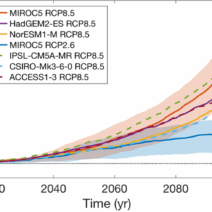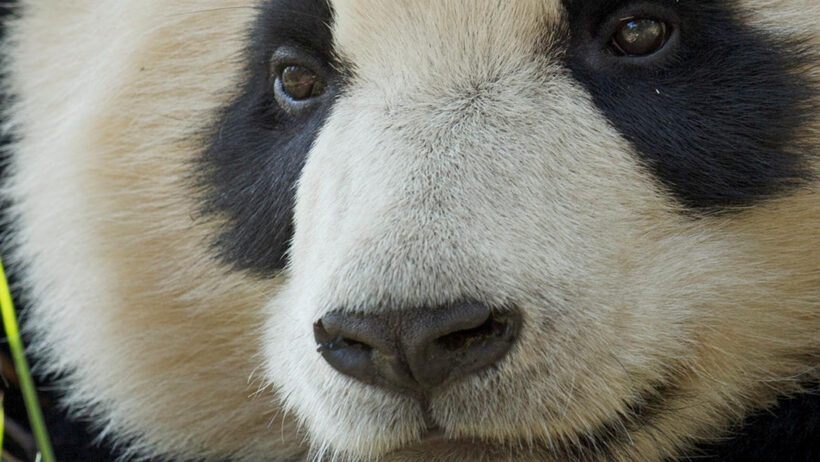The majestic giant panda, symbol of conservation and a beloved creature of the natural world, is facing significant threats from an unexpected adversary: climate change. As we delve into the predicament of these iconic animals, one must ponder a playful question: How can such seemingly resilient creatures be teetering on the brink of survival in an ever-warming world? The answer, unfortunately, lies in the intricate relationship between giant pandas and their habitat—an ecosystem that is being compromised by global climate shifts.
First, it’s crucial to appreciate the unique biology and ecology of giant pandas. Native to the mountainous regions of central China, giant pandas primarily inhabit bamboo forests. Their diet is overwhelmingly composed of bamboo, which constitutes around 99% of their food intake. This dietary specialization renders them highly vulnerable; when bamboo forests suffer from environmental stress, so do the pandas that rely on them. The role of bamboo in the panda’s life cannot be overstated; it is not merely a food source but a vital element of their habitat that supports their reproductive success and overall health.
However, climate change is radically transforming the landscape in which giant pandas thrive. Research suggests that rising temperatures could drastically alter the growth patterns of bamboo, potentially leading to mass die-offs. This phenomenon, coupled with shifting climatic zones, means that viable bamboo habitats are migrating upward into higher altitudes—regions that may not be accessible to pandas. As temperatures continue to climb and weather patterns become increasingly erratic, one must question: Are pandas prepared to adapt to these changing conditions? Their historical conservation efforts focus largely on habitat preservation, but can that be enough in the face of climate unpredictability?
The potential loss of bamboo due to climate change is exacerbated by another dire challenge—deforestation. While deforestation is frequently driven by human activities such as agriculture and urban expansion, climate change compounds these effects by influencing the health of existing forests and their ability to support wildlife. Fragmented habitats further isolate panda populations, making it increasingly difficult for them to find the necessary food resources, mates, and sufficient territory for foraging. This isolation not only imperils their immediate food supply but also threatens the long-term genetic diversity necessary for their survival. Without genetic diversity, pandas face compromised health and an increased susceptibility to disease, creating a precarious cycle of decline.
As the climate crisis continues to escalate, conservation strategies must evolve to account for the dynamic nature of ecosystems and the challenges posed by climate change. Preservation of panda habitats through national parks and reserves, while essential, may no longer suffice if those areas become unsuitable due to altered climate conditions. New frameworks for conservation are being explored—efforts to restore bamboo forests in regions that are climatically more stable and accessible, for instance. Such initiatives not only require significant funding and political will but also collaboration with local communities that rely on bamboo for their livelihoods.
Tackling the broader implications of climate change for giant pandas necessitates a multidisciplinary approach. Incorporating climate science with traditional conservation biology creates opportunities for innovative strategies that engage communities, policymakers, and environmental advocates. Public awareness initiatives play a pivotal role in garnering support for larger policy changes aimed at reducing fossil fuel emissions, which are the primary drivers of global warming. Through advocacy, education, and engagement, environmental activists can galvanize action on the systemic issues that threaten not just giant pandas, but countless other species and ecological systems around the globe.
Another avenue worth exploring is the migration corridors for large mammals, tailored to secure safe passages for pandas and other wildlife between fragmented habitats. These corridors can be essential as climate change forces species to move to more suitable environments. Nevertheless, the establishment of such corridors requires careful planning, coordinated efforts between different regions, and a commitment to ecosystem connectivity. The challenge here is substantial—how do we ensure that anthropogenic barriers such as urban areas and roads do not hinder these vital migration paths?
Moreover, engaging in global discourse about climate change is crucial. The plight of the giant panda exemplifies a broader narrative about biodiversity loss and the importance of robust ecosystems in combating climate change. By emphasizing the interconnectedness of species and their environments, advocates can foster a collective responsibility toward preserving our planet’s health. Mobilizing international efforts and financing for sustainable conservation initiatives might be our best hope for ensuring that future generations still have the awe-inspiring opportunity to witness these remarkable animals.
In conclusion, the giant panda’s future hangs in a delicate balance, swayed by the forces of climate change and human activity. As we confront the multifaceted challenges posed to this iconic species, it is crucial to adopt a forward-thinking mindset. It requires collaborative, innovative strategies that encompass habitat preservation, genetic management, and climate resilience. Just as the giant panda’s survival depends on the preservation of its bamboo forests, so too does our broader stewardship of the planet rest upon our ability to adapt, innovate, and unite in the face of adversity. Are we prepared to rise to the challenge and secure a future not only for the giant panda but for all species at risk? The answer to that question will determine our legacy in the ongoing saga of nature’s intricate balance.







